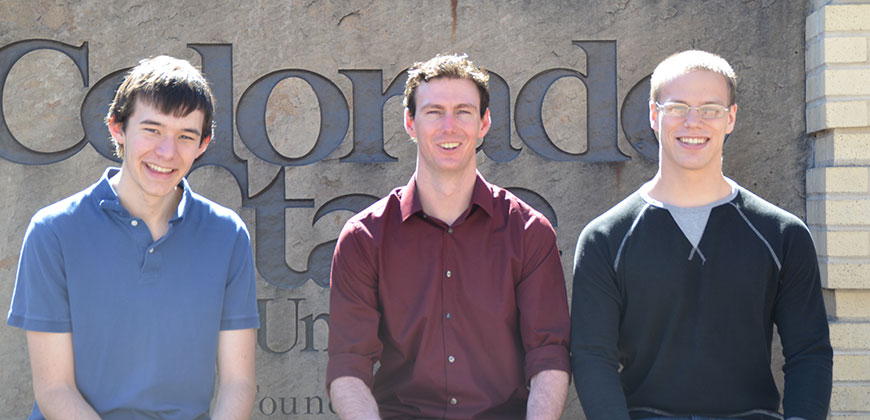
The Brain-Controlled Smart Home senior design team: Colt Darien, Kyle Van Cleave and Ed Okvath.
Training to be an engineer comes by doing. For two semesters, Colorado State University seniors have been planning, designing, building and troubleshooting a dizzying array of projects that showcase the very best of CSU engineering education – innovative ideas, products and concepts that just might change the world.
These senior design projects, the capstone of every engineering major’s academic career, will be on display for the public, industry and others during Engineering Days (E days), April 15, 9 a.m.-3 p.m. at the Lory Student Center.
The goal: A brain-controlled smart home
For computer engineering majors Colt Darien, Ed Okvath and Kyle Van Cleave, their project, “Brain Controlled Smart Home,” was motivated by something very real: the 53 million Americans who live with a limb impairment. From their mid-project report: “For these individuals, completing tasks such as locking doors, enabling/disabling lights, or even changing the channel on television, cannot be done by themselves. The problem faced today is, how can their quality of life be improved?”
How about controlling things with your mind? Under the tutelage of their project advisor, Associate Professor Sudeep Pasricha, the students harnessed the science of electroencephalography (EEG) to turn electrical signals from the brain into actions like switching lights, opening doors, etc.
It sounds too good to be true – but that’s what engineers do: change the world by tackling impossible-sounding problems. “When we first started, we talked about veterans who come back from war with limb disabilities. We hoped to be capable of measuring stimuli from the brain and use them as inputs, just like traditional inputs like the buttons on your phone,” Van Cleave said.
For their project, the students used the Emotiv EPOC+ headset, which uses EEG technology to detect neural activity. The wrote code that would interpret cognitive commands into physical events. To keeps costs low they used Unity, a game development software, to create a virtual reality environment. That included a model home – since they couldn’t build an actual home – to simulate a user’s experience. They utilized the popular Oculus Rift for the virtual reality interface.
First, prove the concept
Their project was a proof-of-concept, and they hope it lives on even after they graduate. They, in fact, inherited the concept from a previous senior design team. The students were able to successfully demonstrate the interpretation of simple thoughts into inputs for electronic devices. The challenges they faced were legion: calibration, latency, and false triggering among them.
Okvath described the need for “powerful thoughts” to generate a good waveform that would perform the desired action. That meant a lot of frustrating false-positive triggers. The more accurate way of measuring brain activity is an implant, but the students specifically wanted a non-invasive, user-friendly product.
“This was a lot of fun,” Okvath said. “The idea behind these projects is to help prepare us to become real engineers.”
And of course, group work, Van Cleave added. So much of engineering education is done in solitude – homework, exams, papers. Senior design is a chance to really understand what it means to work as a team on a very challenging problem.
“It was a good experience to work on a project like this,” Van Cleave said. “There are things that hang you up that you’d never think of. There are things that take a lot of time that you don’t expect.”
Hear more from these students, and many others, at E Days, April 15. The event is free and open to the public.